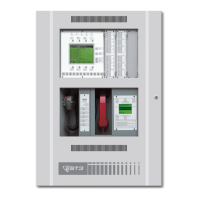System overview
EST3 Installation and Service Manual 1.27
The alarm sensitivity setting may be individually set for each
detector using the SDU program.
Alternate alarm sensitivity setting
Alternate alarm sensitivity refers to the secondary threshold
(expressed in percent smoke obscuration) at which the smoke
detector goes into alarm. The alternate alarm sensitivity setting
for smoke detectors can be set to one of the same five sensitivity
levels as the primary alarm. When smoke detectors having both
ionization and photoelectric elements are used, the sensitivity
setting applies to both elements. This feature permits increasing
or reducing an individual detector’s sensitivity at various times
of the day, dependent upon, environmental conditions,
occupancy, manufacturing processes, etc. Increased sensitivity is
typically used when a facility is unoccupied. Reduced sensitivity
is typically used to reduce the occurrence of nuisance alarms
when occupancy or environmental conditions may create
prealarm conditions. An alternate alarm sensitivity setting for
each detector can be set using the SDU program.
Alarm verification
Upon receipt of the initial alarm signal from a verified detector,
the EST3 panel issues a detector reset command. After a
programmable reset/retard period, if the detector continues to
generate an alarm during the fixed confirmation period, the
alarm is considered valid and processed by the EST3 control
panel. Alarm verification reduces the occurrence of nuisance
alarms, as it provides a time frame in which the cause of the
alarm can be investigated to determine whether an actual alarm
condition exists. The alarm verification period can be increased
or decreased through the SDU program, as limited by the listing
agencies.
Alternate alarm verification
The alternate alarm verification feature operates the same way
the alarm verification feature operates using a second, alternate,
programmed reset/retard period.
Prealarm setting
Signature smoke detectors can be configured to enter a prealarm
state, which generates a monitor event message. Detectors
configured for prealarm have a prealarm pseudo point for which
rules can be written.
During configuration, you specify a percentage of the alarm
sensitivity setting that will generate a prealarm event.

